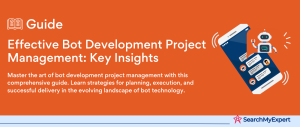The Emergence of Voice Bots: Revolutionizing Interaction in the Digital Age
In today’s fast-paced digital world, voice bots have emerged as a groundbreaking technology, fundamentally transforming how we interact with devices and digital services. These advanced software applications, powered by artificial intelligence (AI), are designed to understand, interpret, and respond to human speech, offering a hands-free and intuitive way of interaction. As we delve into the realm of voice bots, it’s essential to understand their core functionalities and the significant impact they are making across various industries.
Understanding Voice Bots: A Technological Marvel
Voice bots, at their core, are AI-driven applications that facilitate voice-based interactions. They are programmed to comprehend spoken language, decipher the intent behind the words, and provide appropriate responses. This functionality is anchored in sophisticated technologies like natural language processing (NLP), speech recognition, and machine learning. These technologies enable voice bots to not only recognize a vast array of human speech patterns but also learn from interactions to improve their responses over time.
Core Functionalities of Voice Bots
- Speech Recognition:
This is the ability of a voice bot to accurately recognize and interpret human speech, converting spoken words into text. This feature is crucial for understanding user queries and commands. - Language Understanding: Once speech is converted into text, voice bots use NLP to comprehend the context and meaning of the conversation. This understanding is key to providing relevant and accurate responses.
- Response Generation: Based on the understanding of the user’s intent, voice bots generate responses that are coherent and contextually appropriate, often in a conversational manner.
- Learning and Adaptation:
Through machine learning algorithms, voice bots continuously learn from interactions, adapting their responses to be more accurate and personalized over time.
The Rising Influence of Voice Technology Across Industries
Voice technology has seen a meteoric rise in popularity and application, making significant inroads into various sectors. This surge can be attributed to the convenience and efficiency it offers, along with the evolving capabilities of voice bots.
- Retail and E-commerce:
Voice bots are revolutionizing the shopping experience by enabling voice-driven searches and transactions, offering a seamless and hands-free shopping journey. - Healthcare: In healthcare, voice bots assist in appointment scheduling, patient data retrieval, and even provide basic healthcare advice, enhancing patient care and operational efficiency.
- Banking and Finance: The finance sector leverages voice bots for services like account inquiries, transaction processing, and financial advice, offering customers a secure and accessible way to manage their finances.
- Customer Service: Voice bots are extensively used in customer service for handling inquiries, providing support, and resolving issues, leading to improved customer satisfaction and reduced response times.
- Smart Home Devices:
They have become integral to smart home ecosystems, enabling users to control various aspects of their home environment through voice commands. - Automotive Industry:
Modern vehicles are increasingly equipped with voice-activated systems, allowing drivers to control navigation, entertainment, and vehicle settings safely while driving.
Voice Bot Development: Crafting the Future of Conversational AI
Developing a voice bot is a complex, multi-stage process that blends technological innovation with a deep understanding of human interaction. Each stage of development is crucial in ensuring the voice bot is effective, engaging, and serves its intended purpose. Let’s explore these key stages in detail.
Conceptualization: Laying the Foundation
- Identifying the Purpose: The first step is to determine the primary function of the voice bot. This could range from customer service and support to aiding in personal tasks or providing information. The purpose shapes the entire development process.
- Understanding the Target Audience: Knowing the audience is critical. Different demographics may have varying preferences and ways of interacting with technology. A voice bot meant for tech-savvy youngsters would be different from one designed for elderly users, both in language and functionality.
Dialogue Design: Crafting the Conversation
- Developing Conversation Flows:
This involves designing the potential dialogues the bot will have with users. It includes mapping out questions, responses, and the logic that dictates the flow of conversation. - Ensuring Natural Interaction: The goal is to make interactions as natural and human-like as possible. This involves using colloquial language, understanding nuances, and responding in a way that feels intuitive to the user.
Speech Recognition and Synthesis: Understanding and Speaking
- Integrating Speech Recognition: This technology allows the bot to understand spoken language. The challenge lies in recognizing various accents, dialects, and speech patterns.
- Implementing Speech Synthesis: Also known as text-to-speech, this allows the bot to convert written responses into spoken words, ensuring that the voice is clear, natural, and pleasant to listen to.
Machine Learning and AI Integration: The Brain of the Bot
- Intent Recognition: Using AI, the bot interprets what the user intends or wants to accomplish through their spoken words. This involves understanding the context and the specific request.
- Context Awareness: The bot must recognize the context of the conversation to provide relevant responses. This could include understanding previous interactions or external factors influencing the conversation.
- Continuous Learning:
An effective voice bot learns from each interaction. Machine learning algorithms help the bot to improve its conversation skills, understand user preferences, and become more efficient over time.
Testing and Deployment: Perfecting and Launching the Bot
- Evaluating Performance: Before launch, it’s crucial to rigorously test the bot in various scenarios to ensure it understands and responds accurately in real-world conditions.
- Refining Functionality:
Based on testing results, developers refine the bot’s functionality, ironing out any issues in speech recognition, conversation flow, or AI responses. - Launching the Voice Bot:
The final stage is deploying the bot to its intended platform, whether it’s a website, mobile app, or a physical device like a smart speaker. - Ongoing Maintenance:
Post-launch, continuous monitoring, and updates are necessary to ensure the voice bot remains effective and up-to-date with the latest language and technology trends.
Navigating the Technological Backbone of Voice Bots
Voice bots are a marvel of modern technology, built upon several critical components that allow them to interact with humans in a remarkably intelligent manner. Understanding these technological elements is key to appreciating the complexity and capabilities of voice bots. Let’s delve into each of these core technologies.
Natural Language Processing (NLP): The Art of Understanding Language
- Fundamentals of NLP: NLP is the technology that enables voice bots to understand and interpret human language. It involves analyzing and making sense of the user’s language, whether written or spoken.
- Roles in Voice Bots: In voice bots, NLP is used to decipher the user’s intent and meaning from their spoken words. This process involves parsing sentences, understanding grammar, and interpreting the nuances of language.
- Challenges and Evolution:
NLP continuously evolves to handle the complexities of human language, including slang, idioms, and varying sentence structures, making voice bots more intuitive and user-friendly.
Automatic Speech Recognition (ASR): Translating Speech into Text
- What is ASR?:
ASR is the technology that converts spoken words into digital text. It is the first step in enabling a voice bot to process and respond to spoken queries. - Importance in Voice Bots: ASR is crucial for a voice bot to understand verbal commands or questions. The accuracy of ASR directly impacts the bot’s ability to comprehend the user’s requests correctly.
- Advancements and Limitations:
While ASR has advanced significantly, challenges like background noise, accents, and speech clarity still pose hurdles in achieving flawless recognition.
Text-to-Speech (TTS): Giving Voice to Text
- TTS Explained:
Text-to-speech technology does the opposite of ASR. It converts digital text into spoken words, allowing the voice bot to communicate with users audibly. - Role in User Interaction:
TTS is essential for making voice bots interactive and engaging. It provides a voice to the bot, making the interaction more human-like. - Quality and Customization:
Modern TTS systems offer a range of voices and intonations, making the bot’s speech sound natural and pleasant. Customizing the voice to suit the bot’s personality or the user’s preference is also possible.
Machine Learning: The Engine of Continuous Improvement
- Understanding Machine Learning:
Machine Learning (ML) is a subset of AI that focuses on developing systems that can learn and improve from experience without being explicitly programmed. - Application in Voice Bots: In voice bots, ML is used for understanding user behavior, refining speech recognition and response generation, and personalizing interactions.
- Adaptation and Evolution:
The more a voice bot interacts with users, the more data it gathers, which ML algorithms use to make the bot smarter, more efficient, and more attuned to the users’ needs.
Voice Bots: Revolutionizing Interactions Across Diverse Industries
Voice bots, with their versatile functionalities, are making significant impacts across various sectors. Let’s explore some of the key industries where voice bots are not just a convenience but a game-changer in terms of efficiency, customer experience, and innovation.
Customer Service: Enhancing Support and Efficiency
- 24/7 Availability:
Voice bots offer round-the-clock support, addressing customer queries anytime, which is a significant advantage over traditional support systems. - Handling FAQs and Basic Requests:
They efficiently handle common queries and requests, freeing human agents to tackle more complex issues. - Personalized Interactions: By accessing customer data, voice bots can provide tailored support, making the customer service experience more relevant and personalized.
E-commerce: Streamlining the Shopping Experience
- Guiding Through Purchases:
Voice bots assist customers in navigating through products, helping them find exactly what they’re looking for. - Product Recommendations:
Based on customer preferences and purchase history, voice bots can make personalized product suggestions, enhancing the shopping experience. - Facilitating Transactions:
They also play a role in simplifying the transaction process, offering a hands-free and secure checkout experience.
Healthcare: Improving Access and Efficiency
- Booking Appointments:
Patients can use voice bots to schedule appointments, reducing administrative workload for healthcare providers. - Answering Common Medical Questions:
They provide answers to frequently asked health questions, offering quick access to information. - Symptom Analysis: Some advanced voice bots are equipped to analyze symptoms and provide preliminary advice, though not a replacement for professional medical consultation.
Education: Personalizing Learning
- Personalized Learning Experiences: Voice bots can adapt to individual learning styles and paces, providing a more personalized educational experience.
- Providing Feedback:
They can assist in language learning or other subjects by offering instant feedback and corrections. - Automating Administrative Tasks:
Tasks like attendance tracking, assignment submission, and scheduling can be efficiently managed by voice bots.
Finance & Banking: Simplifying Financial Management
- Account Management Assistance:
Voice bots enable customers to check balances, view transaction history, and manage accounts through voice commands. - Processing Transactions:
Users can make payments or transfer money using secure voice commands. - Answering Financial Queries:
From investment advice to general financial inquiries, voice bots can provide immediate responses.
Entertainment & Media: Enhancing User Experience
- Playing Music and Media: Users can command voice bots to play music, movies, or podcasts, offering a convenient way to access entertainment.
- Controlling Smart Devices: Integration with smart home devices allows users to control their environment through voice commands.
- Personalized Recommendations: Voice bots can suggest music, shows, or movies based on user preferences and past choices.
Voice Bots: Balancing Benefits and Challenges in a Digital World
Voice bots, while offering numerous advantages, also face certain challenges that need to be addressed for their effective and ethical use. Let’s explore these aspects to understand the full scope of voice technology in today’s world.
Advantages of Voice Technology
Improved User Experience
- Convenience: Voice bots offer a hands-free, efficient way to interact with technology, making tasks like searching, shopping, or managing devices easier.
- Accessibility:
They provide an essential service for individuals with physical or visual impairments, making technology more inclusive. - Natural Interaction: Voice bots enable more human-like interaction, breaking down the complexity and making technology user-friendly for all age groups.
Increased Efficiency
- Automating Routine Tasks: By handling repetitive tasks, voice bots free up human resources to focus on more complex issues.
- Reducing Wait Times:
They offer immediate responses, significantly reducing wait times compared to traditional customer service channels. - Streamlining Operations: In industries like healthcare and banking, voice bots streamline operations, improving overall efficiency and customer satisfaction.
Enhanced Data Collection and Analysis
- User Insights: Interactions with voice bots provide valuable data on user preferences and behavior, helping businesses tailor their services.
- Voice Pattern Analysis: Voice bots can analyze speech patterns to offer personalized experiences and even detect emotional states or health conditions.
Challenges of Voice Technology
Privacy Concerns
- Data Security:
With voice bots collecting vast amounts of personal data, ensuring the security and privacy of this data is paramount. - Ethical Considerations: The ethical use of voice data, especially in terms of consent and transparency, is a critical concern that needs addressing.
Accessibility Limitations
- User Demographics:
Not all user groups are equally comfortable with voice technology, leading to a digital divide. - Technological Barriers: In regions with limited technological infrastructure, the deployment and effectiveness of voice bots can be hindered.
Language Limitations
- Accuracy Issues:
Voice bots may struggle with accurately understanding diverse accents, dialects, and colloquial language. - Support for Multiple Languages:
Providing support for a wide range of languages and dialects is a challenge that needs constant development and refinement.
Voice Bots: Navigating the Future of Digital Interaction
The landscape of voice bots is evolving rapidly, with advancements in technology broadening their capabilities and applications. Let’s delve into the future trends and opportunities that are shaping the trajectory of voice bot technology.
Integration with Augmented Reality (AR) and Virtual Reality (VR)
- Creating Immersive Experiences: The combination of voice bots with AR and VR is poised to create highly immersive and interactive experiences. In this realm, voice commands could control virtual environments or interact with augmented overlays, making the experience more natural and engaging.
- Educational and Training Applications: In educational and training scenarios, this integration can facilitate a more interactive learning environment. For instance, medical students could use voice commands to navigate through a virtual anatomy lesson.
- Retail and Real Estate Innovations: AR/VR combined with voice bots can revolutionize retail and real estate. Customers could virtually tour properties or try products using voice-guided AR/VR systems, enhancing the decision-making process.
Development of More Sophisticated AI and NLP Capabilities
- Enhanced Conversation Quality:
Future developments in AI and NLP are expected to significantly improve the conversational abilities of voice bots, allowing for more nuanced and context-aware interactions. - Personalization and Predictive Responses:
Advancements in AI could enable voice bots to offer highly personalized experiences, predicting user needs and preferences based on previous interactions and data analysis. - Emotion Recognition:
Emerging capabilities may include emotion recognition, where voice bots can understand and respond to the emotional state of the user, adding a new layer of interaction.
Increased Voice-Based Interactions in Smart Homes and Connected Devices
- Smart Home Integration: The integration of voice bots into smart home technology is expected to deepen, with voice commands becoming a primary mode of interaction for controlling and automating home environments.
- Centralized Control of Connected Devices:
Voice bots could evolve to become the central interface for managing interconnected devices within the IoT ecosystem, offering streamlined and efficient control. - Enhancing Accessibility and Convenience:
The expansion of voice-based interactions in homes and with connected devices will significantly enhance accessibility, making technology more user-friendly for diverse user groups, including the elderly and people with disabilities.
Voice Bots: Transforming Industries and Raising Ethical Questions
As we conclude our exploration of voice bots, it’s clear that these technologies are not just a fleeting trend but a significant development in the digital landscape. Let’s summarize the key points about voice bot development and their potential impact, as well as highlight the ethical considerations crucial for their responsible use.
Summarizing Voice Bot Development and Impact
Voice bots, powered by advancements in AI, NLP, ASR, and TTS, are revolutionizing how we interact with technology. Their development involves a multi-faceted process, beginning with conceptualization and ending with deployment and ongoing refinement. The core functionalities of these bots, such as understanding human speech, interpreting intent, and providing intelligent responses, make them versatile tools across various sectors.
Their impact is widespread:
- In customer service, they offer 24/7 support and improve efficiency.
- E-commerce benefits from enhanced customer interaction and streamlined shopping experiences.
- Healthcare sees improved appointment scheduling and patient engagement.
- Education sectors are utilizing them for personalized learning and administrative tasks.
- Finance and banking enjoy more efficient transaction processing and account management.
- Entertainment and media industries leverage them for personalized content delivery and smart device integration.
Furthermore, the integration of voice bots with emerging technologies like AR/VR and the continuous enhancement of AI and NLP capabilities point to a future where voice bots become even more sophisticated and integral to our daily lives.
Ethical Considerations and Responsible Use of Voice Technology
However, with great power comes great responsibility. The increasing use of voice bots raises several ethical considerations:
- Data Privacy and Security: As voice bots collect and process vast amounts of personal data, ensuring the privacy and security of this information is paramount. Users’ consent and transparent data handling practices are essential.
- Accessibility and Inclusivity:
Voice technology should be developed with a focus on inclusivity, ensuring that it caters to diverse user groups, including those with disabilities and non-native language speakers. - Bias and Fairness:
It’s crucial to address and mitigate any biases in voice recognition and response generation to ensure fairness and impartiality in user interactions. - Responsible Usage: Developers and users alike must be mindful of the ethical implications of voice technology, including its potential impact on employment and personal interactions.
Conclusion:
Voice bots represent a significant leap in technological advancement, offering transformative impacts across various sectors. From enhancing customer experiences to streamlining operations in healthcare and banking, the capabilities of voice bots are extensive and growing. However, as we embrace these advancements, it is crucial to address the ethical considerations inherent in voice technology, such as data privacy, accessibility, and unbiased algorithms. Balancing innovation with responsible usage will be key in harnessing the full potential of voice bots, ensuring they contribute positively to our digital future and align with societal values and needs.
Navigate the future of automation with experienced Bot Development Service Agencies.
Table of Contents
Toggle






